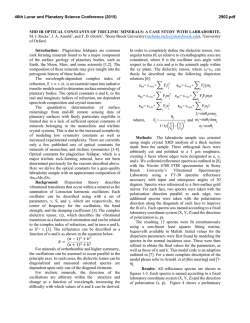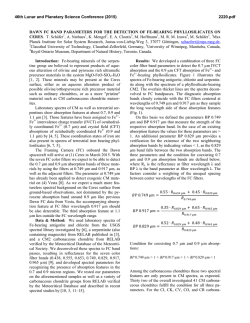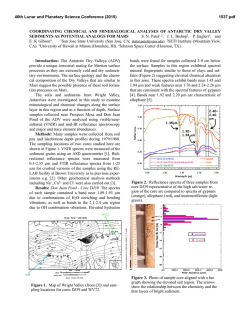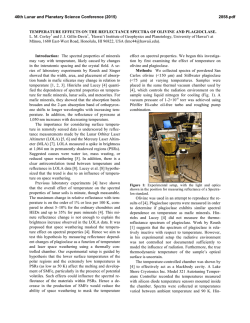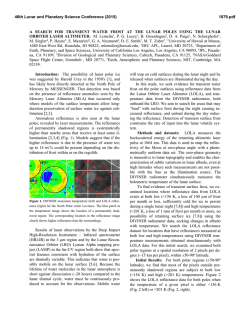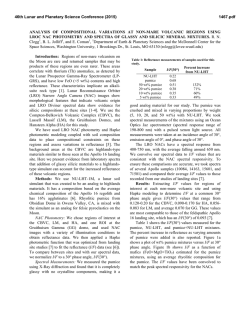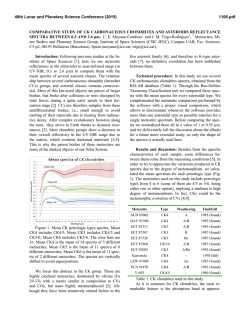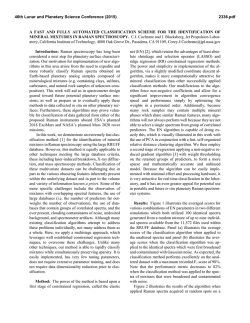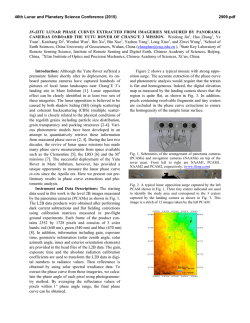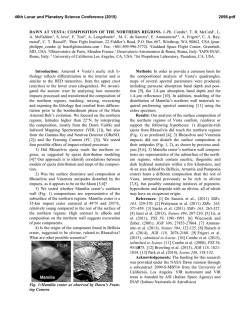
INFRARED (2.5-25.0 µm) REFLECTANCE OF SOLID STATE
46th Lunar and Planetary Science Conference (2015) 2588.pdf INFRARED (2.5-25.0 µm) REFLECTANCE OF SOLID STATE POLYCYCLIC AROMATIC HYDROCARBONS (PAHs). D. M. Applin1*, M. R. M. Izawa1,2, and E. A. Cloutis1 1 Hyperspectral Optical Sensing for Extraterrestrial Reconnaissance Laboratory, Department of Geography, University of Winnipeg, 515 Portage Ave., Winnipeg, Manitoba, Canada, R3B 2E9. 2Dept. of Natural History, Royal Ontario Museum. 100 Queen's Park, Toronto, ON, Canada*[email protected] Introduction: PAHs are highly abundant throughout the universe. PAHs likely form surface deposits on some bodies in the solar system , such as Iapetus [1]. Both atmospheric and surface spectral features on Titan may also be explained by PAHs [2,3]. Fundamental absorption bands of PAHs in the gas phase have been well characterized. PAHs generally have fundamental absorption bands at ~3.3 µm, ~6.3 µm, ~7.8 µm (vCC , ~8.6, and ~11.2 µm . Although these are the strongest features, there are many uncharacterized features that could play a role in the remote sensing of PAHs in the solar system. Reflectance spectra of materials in the solid state can appear considerably different than transmission measurements in the gas phase. Since these materials are expected to exist as solids in surface deposits, the investigation of their spectral properties is timely. Diffuse reflectance spectroscopy in the Vis-nIR (0.4-2.5 µm) has recently been used to characterize a diverse suite of solid state PAHs [4]. Here, we extend that survey into the infrared. Methods: A diverse suite of PAHs were drysieved to their <45 µm fractions, and loaded into aluminum sample cups with a 1 cm diameter and 1 cm depth. Diffuse reflectance spectra from 2.0-25.0 µm were collected with a Bruker (Billerica, MA) Vertex 70 Fourier Transform Infrared (FTIR) spectrometer over the wavelength range of 2.0-25.0 µm at 293K. Reflectance spectra were acquired relative to a Labsphere Infragold® 100% reflectance standard measured at i=30° and e=0° using a SpecAc Monolayer grazing angle specular reflectance accessory. A total of 1500 spectra, collected at a scanner velocity of 40 kHz, were averaged to improve SNR. All measurements were made using an identical viewing geometry, integration time, and number of averaged spectra. 3.27 µm band: All PAHs show this characteristic absorption band (Fig. 1). The center varies from ~3.403.80 µm in the compounds studied. The width of this feature is also considerably larger than that in the gas phase, even more so than expected in some cases. The depth of this feature is also variable. 3.4 µm band: Despite not containing aliphatic components, some PAHs show absorption features near 3.4 µm. These features are present in a many of the PAHs, and are strong in some, and may be due to trace amounts of aliphatics in our samples, which are of variable purity (most >98% pure). 5.05 µm band: The only compound to show features consistent with Titan at 5.05 and 5.1 µm is 2acetylfluorene (Fig. 3), and these features are tentatively ascribed to overtones of the CC stretch and CH3 rocking modes near 10 µm. The reflectance of this compound is also consistent with Titan in the ~2.8 µm region. Discussion and conclusions: Although we have yet to complete full systematic analysis of the spectra, some results are clear. The centers of some features (3.27 µm) don’t appear to be affected strongly by variations in side groups, number of cyclic rings, and other coordination variations, but could be used for identification in high spectral resolution datasets. Overall, the spectra of solid state PAHs can vary significantly. The width of the 3.27 µm absorption is considerably wider than that in the gas phase, or even assumed width in some spectral models. The depth of this feature is correlated with PAH size, as there are fewer CH bonds per volume in larger molecules. Many PAHs show a strong 3.4 µm absorption which can be confused for aliphatic components. This has implications for modelling organic content where a mixture of aromatic and aliphatic components are expected, such as the surface of Iapetus. Finally, out of 50 PAH compounds studied, 2acetylfluorene is the only one that significantly matches the surface reflectance spectra of Titan. This may be consistent with the photochemistry in the atmosphere of Titan, where acetyl and benzene radicals are expected to play roles [5]. This indicates that small PAHs with acetyl side groups may be a component of Titan’s surface deposits. Acknowledgements: This study is supported by the Canadian Space Agency (CSA) through various programs, NSERC, and the U. of Winnipeg. HOSERLab was established with funding from CSA, the Canada Foundation for Innovation, the Manitoba Research Innovations Fund, and the University of Winnipeg. References: [1] Cruikshank, D.P., et al. (2014) Icarus, 233, 306-315. [2] López-Puertas, M. et al. (2013) The Astrophy. Jour., 770, 132. [3] Clark, R.N., et al. (2013) AAS 45, abstract #309. [4] Izawa, M.R.M., et al. (2014) Icarus 237, 159-181. [5] Krasnopolsky, V.A. (2009) icarus,201, 226-256.. 46th Lunar and Planetary Science Conference (2015) 2588.pdf Figure 1. Reflectance spectra of some PAH compounds. Lines indicated position of characteristic PAH absorption features in the gas phase. Figure 3. Reflectance spectra of some PAHs. The black line indicats the center of the absorption band identified on Titan. Figure 2. Reflectance spectra of some PAHs showing the 3.27 µm absorption band.
© Copyright 2025
